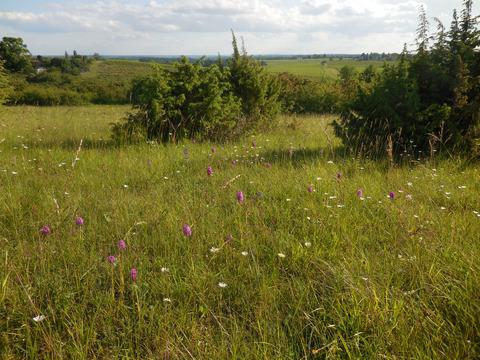Our official English website, www.x-mol.net, welcomes your feedback! (Note: you will need to create a separate account there.)
Species stress tolerance and community competitive effects drive differences in species composition between calcareous and siliceous plant communities
Journal of Ecology ( IF 5.5 ) Pub Date : 2021-09-28 , DOI: 10.1111/1365-2745.13785 David Nemer 1 , Pierre Liancourt 2, 3 , Florian Delerue 4, 5 , Hugo Randé 1 , Richard Michalet 1
中文翻译:

物种胁迫耐受性和群落竞争效应导致钙质和硅质植物群落之间物种组成的差异
更新日期:2021-09-28
Journal of Ecology ( IF 5.5 ) Pub Date : 2021-09-28 , DOI: 10.1111/1365-2745.13785 David Nemer 1 , Pierre Liancourt 2, 3 , Florian Delerue 4, 5 , Hugo Randé 1 , Richard Michalet 1
Affiliation

|
- Both chemical and physical properties of soils have been used for two centuries for explaining differences in species composition and diversity between plant communities from calcareous and siliceous soils. Here, we examine the prediction from the ‘physical hypothesis’, which proposes that species from siliceous soils are absent from calcareous soils because of high drought stress, while species from calcareous soils are absent from siliceous soils because of high competition due to higher water availability. This hypothesis therefore predicts a trade-off between stress tolerance and competitive response that allows calcareous and siliceous species to dominate their respective communities. There has been no attempt to experimentally assess these predictions.
- We cross-transplanted with and without neighbours using a removal experiment, two dominant species from calcareous soils (Bromus erectus and Brachypodium sylvaticum) and two species from siliceous soils (Pseudarrhenatherum longifolium and Deschampsia flexuosa) in herbaceous communities from the two soils types. We repeated the experiment 4 years, taking advantage of inter-annual climatic variability to test the interplay between year quality (dry vs. wet years) and soil types on survival responses with and without neighbours. We quantified species stress tolerances, their competitive responses and the competitive effect of the two community types.
- In the absence of neighbours, species from siliceous soils had much lower survival than species from calcareous soils during dry years, in particular on calcareous soils. It indicates a lower stress tolerance of siliceous species and a higher level of stress occurring on calcareous soils. Competition strongly reduced the survival of calcareous but not siliceous species, indicating a greater competitive response of the latter and competition was more important on siliceous soils than on calcareous soils during wet years. However, we found that species stress tolerances were more important than competitive effect of neighbours in driving differences in species composition.
- Synthesis. The contrasting responses found for dominant species from calcareous and siliceous soils support the trade-off between stress tolerance and competitive response proposed by the physical hypothesis. Our results bring additional evidence that differences in water availability and stress between the two soil types are driving species responses to bedrock types.
中文翻译:

物种胁迫耐受性和群落竞争效应导致钙质和硅质植物群落之间物种组成的差异
- 两个世纪以来,土壤的化学和物理特性都被用来解释钙质和硅质土壤中植物群落的物种组成和多样性差异。在这里,我们检查了“物理假说”的预测,该假说提出,由于高干旱胁迫,钙质土壤中不存在来自硅质土壤的物种,而由于较高的水可用性,竞争激烈,因此硅质土壤中不存在来自钙质土壤的物种。 . 因此,该假设预测了压力耐受性和竞争反应之间的权衡,允许钙质和硅质物种主导各自的群落。没有尝试通过实验评估这些预测。
- 我们使用去除实验在有和没有邻居的情况下交叉移植了两种土壤类型的草本群落中钙质土壤中的两种优势物种(Bromus直立和Brachypodium sylvaticum)和硅质土壤中的两种物种(Pseudarrhenatherum longifolium和Deschampsia flexuosa)。我们重复了 4 年的实验,利用年际气候变化来测试年份质量(干与湿年份)和土壤类型之间的相互作用对有和没有邻居的生存反应。我们量化了物种的压力耐受性、它们的竞争反应和两种群落类型的竞争效应。
- 在没有邻居的情况下,在干旱年份,尤其是在钙质土壤上,来自硅质土壤的物种的存活率远低于来自钙质土壤的物种。它表明硅质物种的应力耐受性较低,而钙质土壤上的应力水平较高。竞争极大地降低了钙质而非硅质物种的存活率,表明后者的竞争反应更大,而且在潮湿年份,硅质土壤上的竞争比钙质土壤更重要。然而,我们发现物种胁迫耐受性在推动物种组成差异方面比邻居的竞争效应更重要。
- 合成。从钙质和硅质土壤中发现的优势物种的对比反应支持物理假设提出的胁迫耐受性和竞争反应之间的权衡。我们的结果提供了额外的证据,表明两种土壤类型之间的水分可用性和压力的差异正在推动物种对基岩类型的反应。


























 京公网安备 11010802027423号
京公网安备 11010802027423号